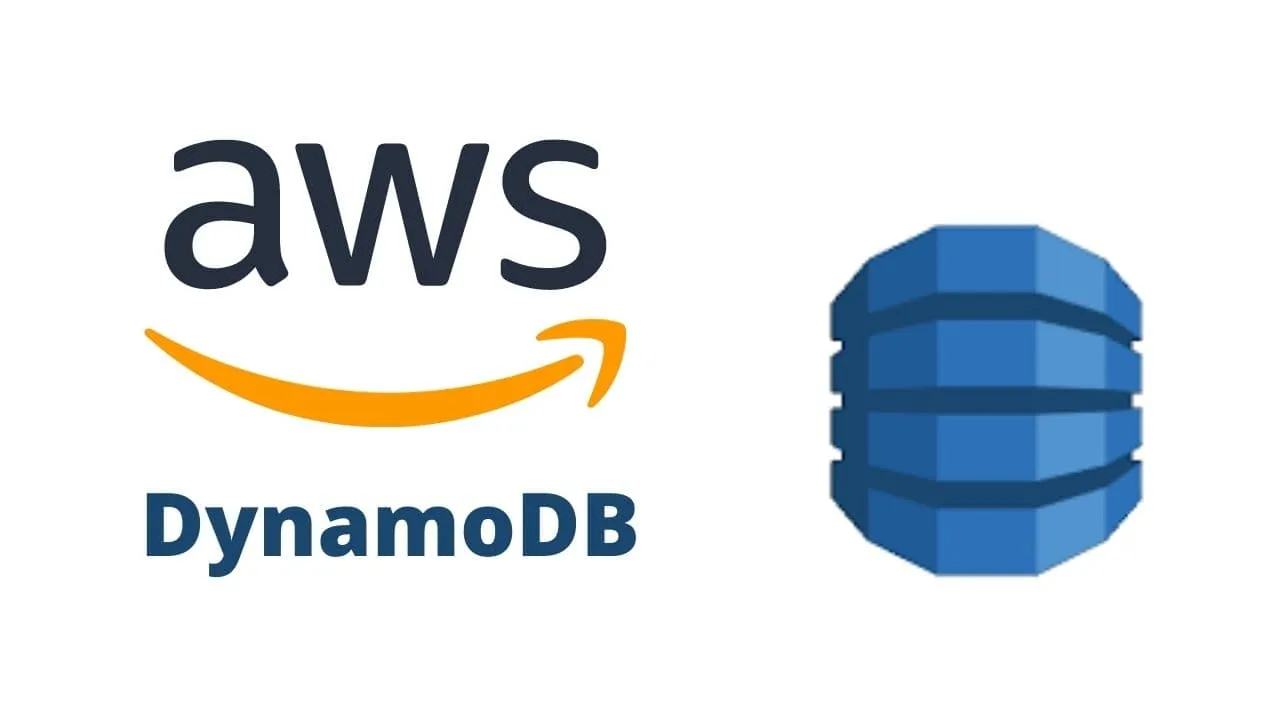In this AWS article, we will be discussing What Is DynamoDB in AWS, a database service provided by AWS, and will be learning more about topics related to Amazon DynamoDB such as:
- What is DynamoDB?
- What is DynamoDB used for?
- Is DynamoDB better than MongoDB?
- What is AWS DynamoDB pricing?
- Where can I find credible DynamoDB documentation?
- Where can I find a good DynamoDB tutorial?
There is always some confusion in new users regarding the popular AWS service DynamoDB.
This is the reason why we have completed a comprehensive guide about AWS DynamoDB so that we can educate new users about DynamoDB features and help them decide if this service is the most suitable for them.
Let’s keep going and try to dig deeper into the amazing DynamoDB service. After reading this article, you will be able to tell the difference between DynamoDB vs. MongoDB and read the extensive AWS DynamoDB documentation comfortably.
What Is DynamoDB?
DynamoDB is a facility from Amazon Web Services that provides users with a high-speed and no-SQL-based database hosted service to users.
DynamoDB allows users to host distributed databases from their servers to AWS in order to help them take the burden off from hardware provisioning, complex configuration, and setup of systems, efficient output planning, confusing replications, or software patching.
This service is a database service available for operating, storing, and working with databases of any scale.
Why was DynamoDB created?
The most helpful point of DynamoDB is that it simplifies the task of scaling databases. It solves the problem of dealing with the complicated management of database software and the provisioning of expensive hardware needed to accommodate it.
Non-relational databases can be easily deployed without any extra delays or hurdles. DynamoDB has the fantastic ability to scale throughput capacity and can help you in meeting the demands of your data.
No matter if your data needs to be partitioned or repartitioned, DynamoDB can take care of it, all the while your data size continues to grow.
To ensure data accessibility and high durability, your data is replicated and synchronized across three regions in the AWS locations to ensure your work continues smoothly always.
Moreover, DynamoDB has the ability to run on all kinds of operating systems (OS) such as Windows, AIX, Linux, iOS, HP-UX, Android, and Solaris.
DynamoDB is an entirely cloud-managed service that can be accessed through APIs. It is highly recommended for new users opt for AWS SDKs to begin working with DynamoDB.
How to create a dynamoDB table?
Have you created a DynamoDB table? If not then follow along we will do it right away.
1. Login to the console and find DynamoDB, you will reach the main page.

2. Go on, and hit the Create Table option.
3. You will now see a host of options to be filled. This we are going by the Default Settings.
Give a name, Partition key, and Sort key, with this we are done. We can go ahead and create a table.
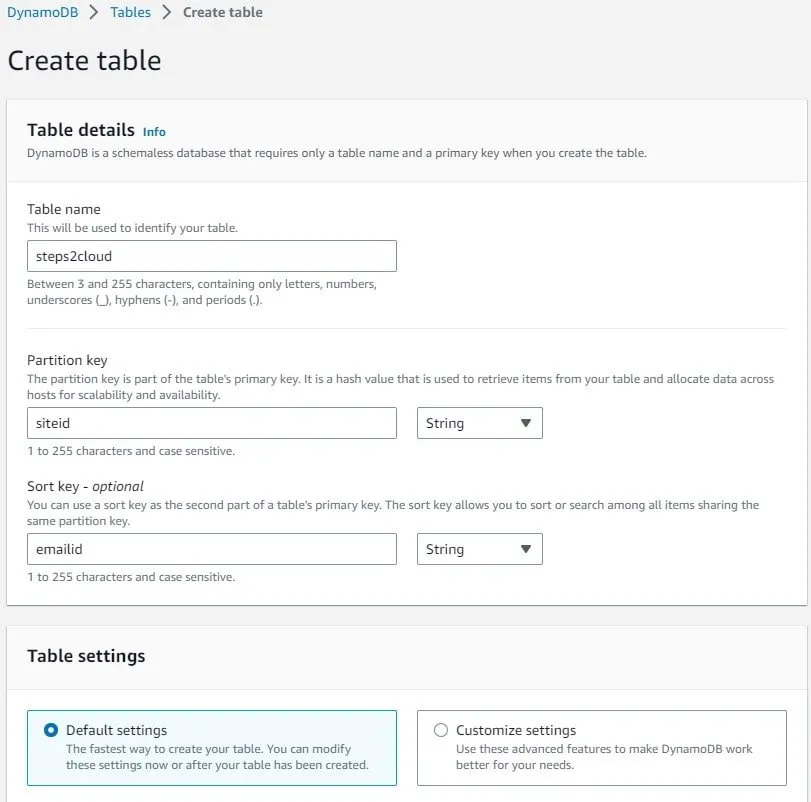
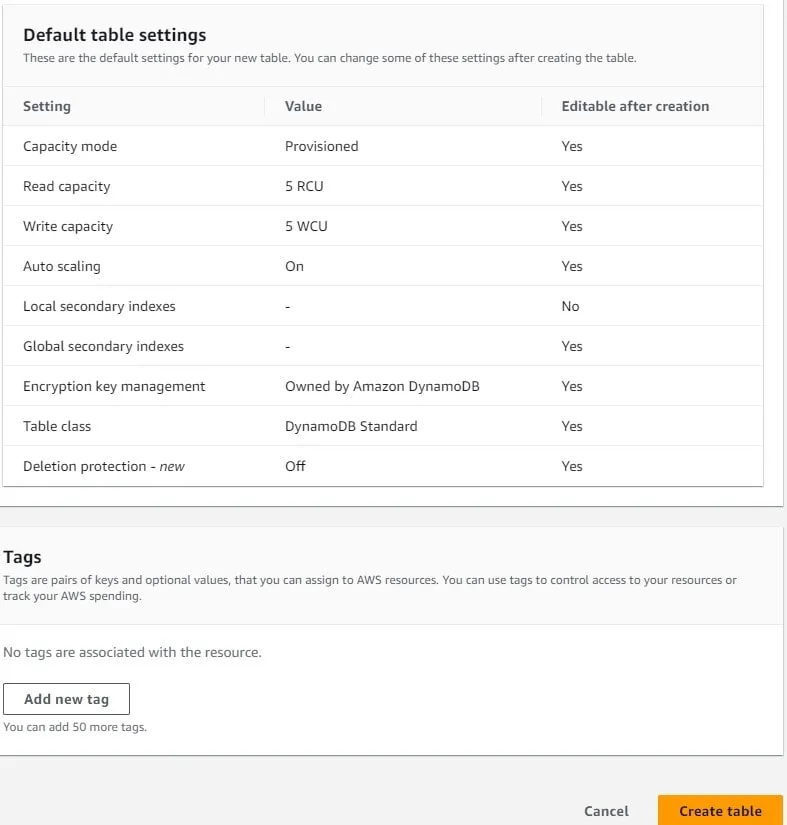
4. But if we would like to go with Custom settings then we would be seeing a lot of other options. Let us have a look at those and try to figure out more about what they are there for.
We have got the option to choose table class, read and write capacity units can be altered, and the DB capacity can also be changed as per our requirement.
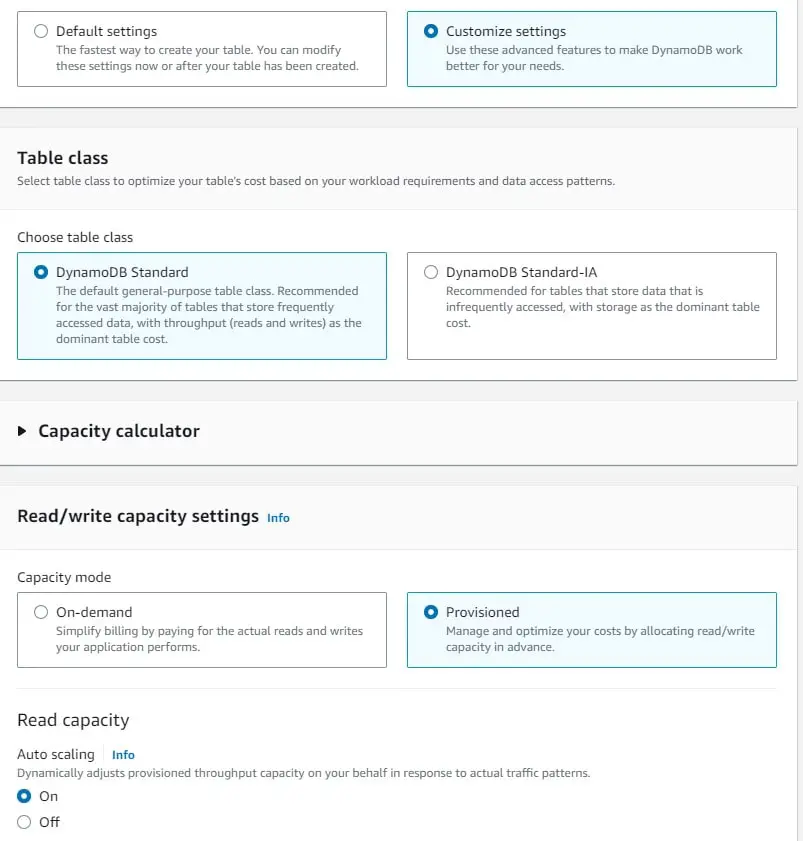
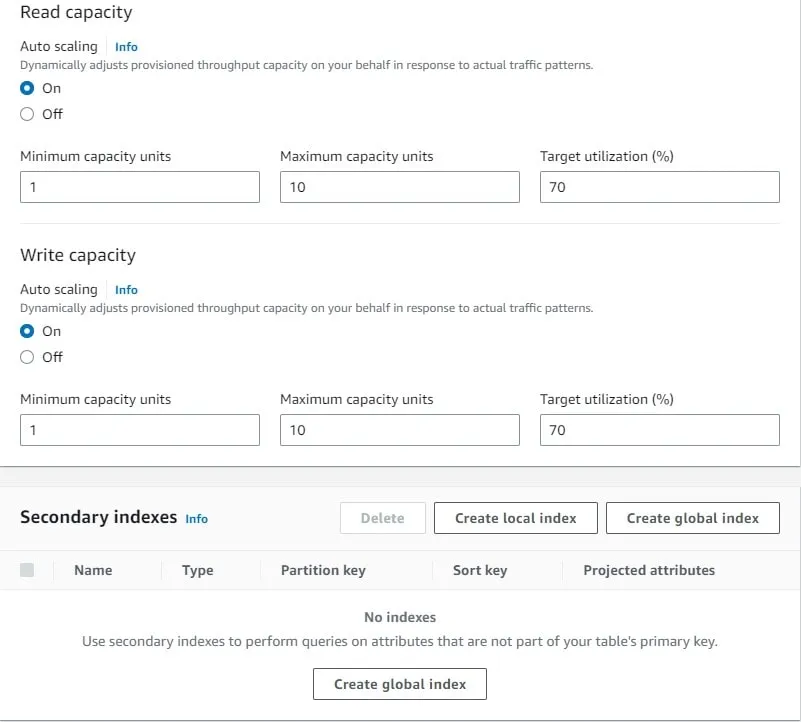
5. Finally we can see the summary of our chosen options below. We have the option to change the encryption of the table.
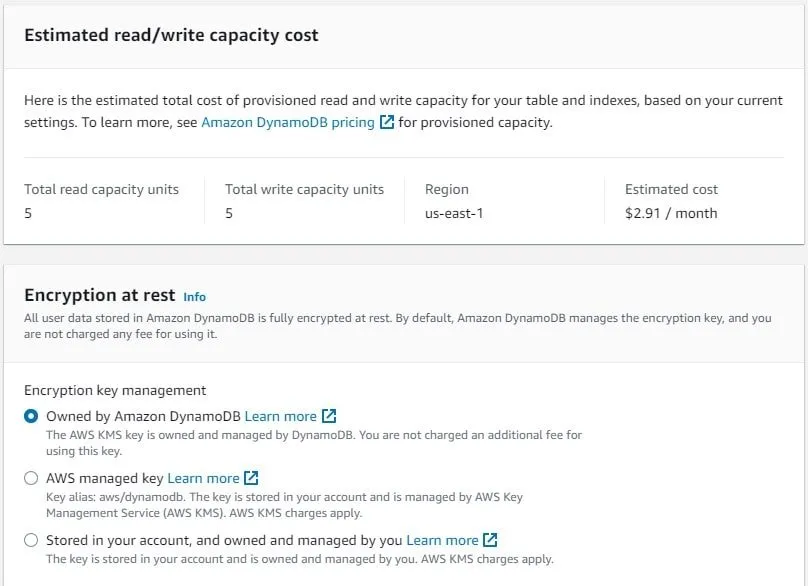
6. Lastly we have to protect the table from accidentally getting deleted.
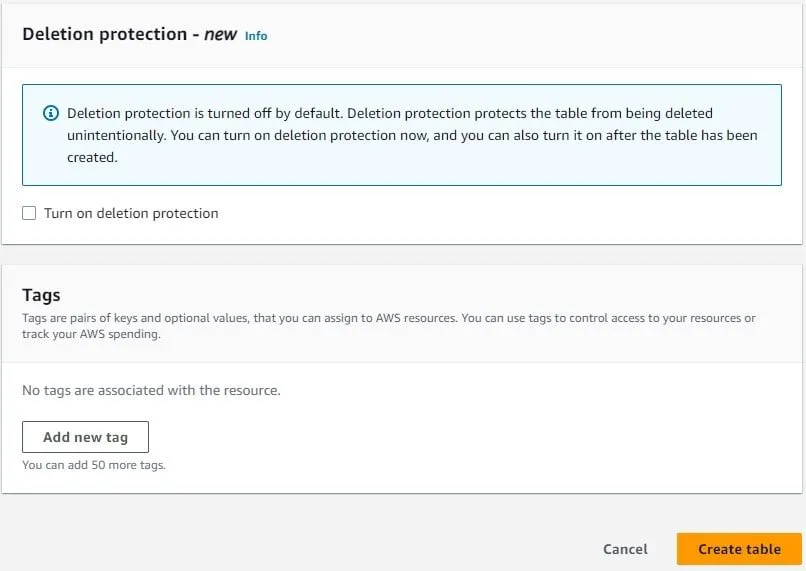
7. Finally your table is successfully created.

What Is DynamoDB Used For?
DynamoDB is a database service that is used commonly by web-based applications to manage the scaling of a growing and complex number of data traffic on a site.
Conventional databases cannot cope with modern workload demands, which require processing data efficiently and quickly.
There is a long list of DynamoDB features, but the main reason for opting for this brilliant AWS service is its scalability and speed.
Let’s find more DynamoDB features
- It can support complex data structures easily and can provide valuable cloud services with automatic scaling.
- AWS offers other remarkable benefits with DynamoDB, such as data backup, restoration options, and memory caching for all types of internet range applications.
- Those who have been in the IT industry for a long time must recognize the challenges that come with scaling databases.
- DynamoDB simplifies the risky and challenging task by auto-scaling to track and gauge your usage to find out if it is close to the upper bounds.
- DynamoDB can help you ensure excellent performance as it helps your system adjust to the number of traffic while also reducing costs.
- Also DynamoDB has the added advantage of providing you access control of your data. You may want to keep your data secure without disrupting the workflow or pace of the company.
- DynamoDB allows you to preside over complete databases with a high and precise level of control.
- DynamoDB allows developers the ability to view and make changes in the data easily. A sequence of changes made to the data is provided as time-ordered streams.
- Another point is that DynamoDB Streams offer great flexibility in working with other AWS services to solve complex problems.
- You can use the DynamoDB API to make complex changes, push small backups to Amazon S3, or retain an updated read-cache. There are several usage instances where this feature becomes increasingly helpful.
- DynamoDB is a no-SQL database model which helps it manage unstructured or less structured data more easily. If the data for your use needs to be in inconsistent schemas, DynamoDB can easily handle that for you.
Another case is when a friend updates their status or posts something on their social media network, the app for the social media network will notify other users with an alert on their mobile phones.
dynamodb vs mongodb: Is DynamoDB Better than MongoDB?
The most important question when dealing with database services is which one is better: DynamoDB or MongoDB?
We have listed down some differences for both services, which will help you determine which service would be the most suitable for you.
- When thinking about the comparison of DynamoDB vs. MongoDB, it is essential to note that DynamoDB is a tightly integrated service of the AWS.
- DynamoDB requires users to configure and run the database through AWS. In contrast to DynamoDB, MongoDB allows you to run or configure the database virtually from a local machine or any deployment on a cloud server.
- DynamoDB is a completely managed database service that allows users to deploy and configure their databases immediately.
- The automatic AWS features of backup, scaling, checking availability, and updates ensure easier data management.
- No hardware infrastructure management is needed as multi-region-based and readily available databases can be accessed quickly using APIs.
- In comparison with DynamoDB, users have to manage the infrastructure and configuration of a MongoDB deployment all on their own.
- While this adds to a higher level of control over the data, it also makes data management and scaling using MongoDB increasingly complex.
What Is AWS DynamoDB Pricing?
On the basis of the capacity modes to be used, DynamoDB from AWS is available in two different packages:
- DynamoDB On-Demand Capacity and
- DynamoDB Provisioned Capacity.
While DynamoDB provisioned capacity option allows users and developers to select the number of needed resources to be allotted to the databases beforehand.
The developers can also set a restricted limit of resources which will allow the database to begin ignoring requests once it has been reached. This action can also be performed by auto-scaling of resources.
Whereas DynamoDB’s on-demand capacity allows everything to become automated. It will automatically adjust the number of services assigned to a database. The automatic adjustment depends on the changes per data usage and variations in API requests in a month.
The pricing is highly complex for DynamoDB, which is why you need to understand the following terms such as: Read request and Write request.
- Read request is a request made from the API to read data from a specified DynamoDB database.
- Write request is the call to edit, add, or delete data from the DynamoDB database.
The total prices you will incur in a month will depend on the number of edits you made and the amount of data storage your databases require.
Nevertheless, data prices can vary from region to region as different AWS locations offer different rates.
You can still incur additional costs due to factors like provisional throughput, data transfer, reserved capacity, data caching, continuous or on-demand backups, data restoration, global deployment, and more.
You can calculate your monthly AWS DynamoDB costs using this calculator or learn more about DynamoDB pricing here.
Where Can I Find Credible DynamoDB Documentation?
DynamoDB documentation for developers can be easily found on the AWS website. It will help you with answers to complex questions regarding deployment, management, and other technicalities with ease.
Amazon Web Services also has added DynamoDB documentation facilities such as FAQs, practical use cases, and a better exploration of its features on its website. AWS DynamoDB documentation pdf can also be downloaded from here.
Where Can I Find a Good DynamoDB Tutorial?
A good DynamoDB tutorial can be easily found on the internet. Still, if you want to start learning DynamoDB from scratch or have a passion for increasing your technical skills, we suggest opting for Amazon’s DynamoDB tutorial.
AWS has developed an excellent course for developers to attain a deeper insight into understanding and working with Amazon DynamoDB.
This course includes real, applicable projects and scenarios, excellent reading materials, tests, and labs to help further your application-based development.
Click here to learn more details about the Amazon DynamoDB course.
dynamoDB vs rDS: Quick comparison
Let’s check out how the two kinds of DBs are different:
| Features | DynamoDB | RDS |
| Type | NoSQL | RDBMS |
| Supports | Only DynamoDB | Oracle, MariaDB, PostgreSQL, MySQL, SQL Server |
| Maintenance | Amazon updates patches. Less user-controlled | Serverless |
| Availability | Supports Multi-AZ deployment | Global tables maintain 3 data copies across AZ and Regions |
| Storage | Up to 128 TB | Unlimited |
| Encryption | Data can be encrypted using KMS | Default Encryption |
dynamodb vs cassandra: Key Diffrences
Both are equally important DB, let’s outline the differences between them:
| Feature | DynamoDB | Cassandra |
| Architecture | Works in one region but replicates its data to 3 AZ. | All nodes have equal weightage and can communicate with the client independently. |
| Data Storage | Key-Value, Partitioned by table size, partition/sort key can have just one attribute | Column Oriented, partitioned by a set of rows, allows more than one column in partition and clustering columns. |
| Performance | The auto-scaling issue, and throttling issue when more read-write requests come as configured in IOPS. | Data consistency issue, Adds records even in the update operation |
| Uses | Best for IoT, gaming applications | IoT, forgery checking system, messaging |
What is dynamoDB global table and how it works?
The concept of a DynamoDB global table is pretty much straightforward when you create a global table then DynamoDB automatically creates exact same replicas across multiple regions of your preferred choice.
When we write to any of the regions the same is propagated to all the regions and this is handled by DynamoDB on its own.

Features:
- Huge boost in performance as the read and write happens locally.
- Setup is pretty simple, just provide the region name and AWS does the heavy lifting of setting it up.
- As we have multiple copies of data so its highly durable and fault tolerant.
- Hassle free usage as any changes in any region is propagated to all the regions on its own.
FAQs [What + How]
Q: How does Python connect to DynamoDB?
Python can connect to DynamoDB with the help of Boto3 client library.
Q: Why is DynamoDB serverless meaning?
It means we don’t have to set up any servers for setting up dynamodb. We just create tables and the rest is taken care of by AWS.
Q: What is dynamodb Transaction?
The transaction is either a Write or a Get operation in DynamoDB. Both of these operations help in Writing and Getting multiple items in a single transaction.
Q: what is dynamodb table?
DynamoDB table is a NoSQL database service provided by AWS. It gives high performance with millisecond latency and highly durable storage.
Q: what is dynamodb Index?
We have two kinds of Index in DynamoDB:
LSI: Local Secondary Index can be created only at the time of table creation, else we cannot.
GSI: Global Secondary Index can be created even after the table is created and we have the option of creating multiple GSI in any DynamoDB table.
Q: what is dynamodb mapper?
This helps to carry out the various operations on the DynamoDB table like create, read, delete, and many more. This is the SDK mainly for java.
Q: what is dynamodb build on?
Dynamo DB is built on top of an SSD for providing high throughputs even when the read and writes are high.
Q: what is dynamodb accelerator
This is an in-memory caching service of DynamoDB. This improves the performance of DynamoDB to a large extent.
Q: amazon dynamodb is a service offered by aws?
Yes, DynamoDB is a NoSQL DB service provided by AWS.
Q: What programming language is DynamoDB written in?
Java is the language behind DynamoDB.
Also, read below AWS article.
- What Is RDS In AWS
- What Is AWS Lambda
- AWS Vs Google Cloud
- AWS Redshift Vs Snowflake
- (Amazon Web Services) AWS Vs Azure
- Hosting Websites On AWS For Free
- How Secure Is AWS And How Does It Work
- How To Reactivate Suspended AWS Account
- Introduction To IAM AWS And How It Works
- Introduction To VMWare AWS Hybrid Cloud?
Conclusion
So we finally went through all the details about DynamoDB, to summarize it’s a no-SQL solution from AWS. It’s fast and highly efficient.
In this article, we hope that you have developed a greater understanding of DynamoDB and the related topics discussed in-depth above:
- What is DynamoDB?
- What is DynamoDB used for?
- Is DynamoDB better than MongoDB?
- What is AWS DynamoDB pricing?
- Where can I find credible DynamoDB documentation?
- Where can I find a good DynamoDB tutorial?
This article should have cleared any confusion you have had in the past about DynamoDB documentation, DynamoDB features, DynamoDB pricing, and more.

I am an Amazon Web Services Professional, having more than 11 years of experience in AWS and other technologies. Extensively working in various AWS tools like S3, Lambda, API, Kinesis, Load Balancers, EKS, ECS, and many more. Working as a Solution Architect and Technology Lead for Architecting and implementing the same for different clients. He provides expert solutions around the world and especially in countries like the United States, Canada, United Kingdom, Australia, New Zealand, etc. Check out the complete profile on About us.

